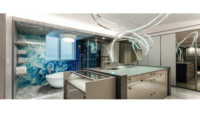The National Kitchen & Bath Association (NKBA) released its annual Design Trends report. The 2022 study, a deep dive into all aspects of both kitchen and primary bathroom design, forecasts the styles, features, materials and innovations expected to be most popular over the next two to three years. The current study finds that the COVID-19 pandemic has accelerated consumer interest in and adoption of key trends in their homes such as integration of smart technology, multi-functional spaces and natural and nature-based designs.
“We’ve seen the pandemic have an effect across all sectors in our society and we’re now starting to see how the change in human behaviors is shifting the way we design our homes,” said Bill Darcy, CEO, NKBA. “Consumers are more eager to embrace new technologies, innovative ways to provide multi-functional options to maximize their space to fit any occasion and are opting for surfaces and designs that make it easier to clean, as well as address health and wellness.”
Smart technology has long been a promised integration into the home and will only continue to rise in popularity among consumers. COVID-19 made people conscious of high-contact surface points, so homeowners increasingly turned to hands-free and voice-activated technology to reduce the spread of diseases. In fact, devices offering touchless technology have become the breakout stars within the kitchen and bath space, making consumers’ lives easier and helping to decrease high contact surface areas.
Yet, while there was buzz around the involvement of technology in 2021, the market remains largely untapped as only 30% kitchen projects and 21% of bathroom designs included some type of integrated appliances.
In addition to smart technology, 58% of designers predict spaces that serve multiple functions will becoming increasingly popular in 2022 and beyond. New millennial homeowners are looking to maximize their kitchen space with islands that serve as a meal prepping area, a work station and a dining table, as well as a place to entertain guests. Furthermore, younger consumers are looking to include laundry facilities inside their bathrooms; maximizing space while freeing up room elsewhere in the home for different activities. With work from home and flexible work days gaining traction in the national workforce, the ability to customize the home space for specific needs will only continue to grow in importance for homeowners.
In that same vein, millennials are leading the increase in natural and contemporary designs, especially within the kitchen and bath. Moving away from white and gray as primary colors, designers expect nature-inspired colors to grow in prominence, notably greens and blues. For fixtures, the trend is toward more matte and brushed finishes in black, stainless, nickel and pewter. Additionally, designers see increased natural light with large high-performance windows and doors for outdoor access becoming more prominent, as homeowners continue to create outdoor living, dining and cooking areas outside the home.
“Besides the pandemic, another rising factor in the design trends we are seeing for 2022 and beyond is the growth of the millennial and gen X customer base, as these homeowners are now reaching the point in their lives where they are increasingly working with designers to create their ideal homes as opposed to attempting to do it themselves,” Darcy added. “These homeowners expect a certain style and flair for their homes, while also showcasing a different vision for what they feel their home should bring to their life. For example, they are requiring both a space for work, as well as, an escape – leading to designs that are both relaxing and reinvigorating.”
While boomers continue to be a large part of designers’ customer base, the demographics are shifting toward a younger audience that is increasingly driving future trends. While gen X remains the biggest age group, with 49% of the design projects customized for them, designers note a 6% increase in work on behalf of millennials. This has resulted in a shift in how designers do business as millennials are more apt to conduct meetings virtually, are almost 10% more likely to want to do the entire project virtually.






